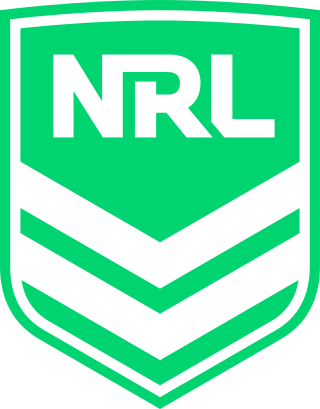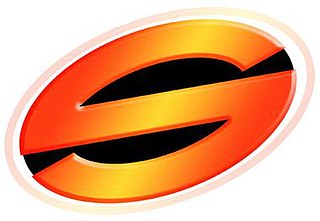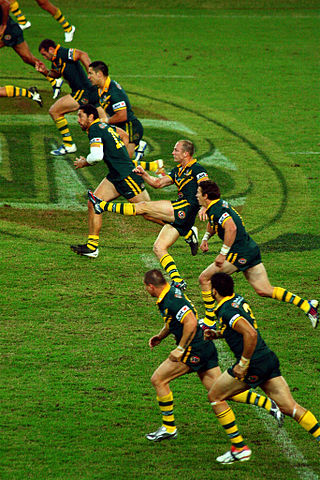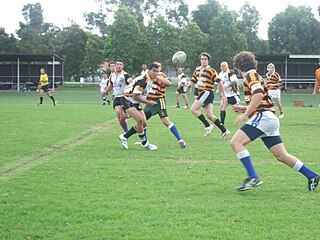
The National Rugby League is a professional rugby league competition in Australasia which contains clubs from New South Wales, Queensland, Victoria, the Australian Capital Territory and New Zealand.

The New South Wales Rugby League (NSWRL) is the governing body of rugby league in New South Wales and the Australian Capital Territory and is a member of the Australian Rugby League Commission. It was formed in Sydney on 8 August 1907 and was known as the New South Wales Rugby Football League (NSWRFL) until 1984. From 1908 to 1994, the NSWRL ran Sydney's, then New South Wales', and eventually Australia's top-level rugby league club competition. The organisation is responsible for administering the New South Wales rugby league team.

Super League was an Australian rugby league football administrative body that conducted professional competition in Australia and New Zealand for one season in 1997. Along with Super League of Europe, it was created by News Corporation during the Super League war which arose following an unsuccessful attempt to purchase the pay television rights to rugby league in Australia. After two years of legal battles the competition was played for a single season in 1997 alongside the rival Australian Rugby League (ARL) competition before the two merged in 1998 to form the National Rugby League (NRL).

The Queensland Rugby Football League (QRL) is the governing body for rugby league in Queensland. It is a member of the Australian Rugby League Commission and selects the members of the Queensland rugby league team.

The Adelaide Rams was an Australian professional rugby league football club based in Adelaide, South Australia. The team was formed in 1995 for the planned rebel Super League competition. The Rams lasted two seasons, the first in the Super League competition in 1997 and the second in the first season of the National Rugby League (NRL) in 1998. The Rams were not a successful club, winning only 13 out of 42 games. However crowd numbers in the first season were the fifth highest of any first-grade club that year, but dwindled to sixteenth in the second season. The Adelaide club was shut down at the end of the 1998 season as a result of poor on-field performances, dwindling crowd numbers, financial losses and a reduction in the number of teams in the NRL. They remain the only team from the state of South Australia to have participated in top-level rugby league in Australia.

The Queensland Cup, currently known as the Hostplus Cup for sponsorship reasons, is the highest-level regional rugby league football competition in Queensland, Australia. It is run by the Queensland Rugby League (QRL) and is contested by fifteen teams, thirteen of which are based in Queensland, with one based in New South Wales and one in Central Province, Papua New Guinea.

Rugby league in Australia has been one of Australia's most popular sports since it started being played there in 1908. It is the dominant winter football code in the states of New South Wales and Queensland. In 2022, it was the most watched sport on Australian television with an aggregate audience of 137.3 million viewers. The premier club competition is the National Rugby League (NRL), which features ten teams from New South Wales, four teams from Queensland, and one team each from Victoria, the Australian Capital Territory and New Zealand. The premier representative competition is the annual Rugby league State of Origin featuring two sides, the New South Wales Blues and the Queensland Maroons is often referred to as "Australian sport's greatest rivalry", it is one of Australia's premier sporting events, attracting huge interest and television audiences.
John Ribot, also known by the nickname of "Reebs", is an Australian sports administrator, former rugby league footballer of the 1970s and 1980s. Once a Queensland State of Origin and Australian international representative, Ribot was the 1980 NSWRFL season's equal top try-scorer. Also a member of the 1982 "Invincibles" Kangaroo touring squad, he played club football in Brisbane for Fortitude Valley, Wests and Redcliffe, and in Sydney for Newtown, Wests and Manly-Warringah.

The NSW Cup, currently known as the Knock-On Effect NSW Cup for sponsorship reasons, is a rugby league competition for clubs in New South Wales. The competition has a history dating back to the NSWRFL's origins in 1908, starting off as a reserve grade competition, and is now the premier open age competition in the state. The New South Wales Cup, along with the Queensland Cup, acts as a feeder competition to the National Rugby League premiership. The competition is the oldest continuous rugby league competition in the Australia.
Mark Coyne is an Australian former rugby league footballer, a state and international representative player and an Insurance Executive. His football club career was with the St George Dragons and the joint-venture of the St George Illawarra Dragons – he captained both sides. He played principally at centre but sometimes as a wing in his notable representative career. He was also the brother of another first grade footballer, Peter Coyne.

David Gallop is an Australian sports administrator, lawyer and served as the chief executive of the Football Federation Australia until December 2019. He previously served as the chief executive officer of the National Rugby League between February 2002 and June 2012. He was also the Secretary of the Rugby League International Federation from its inception in 1998 up until his resignation on 5 June 2012.
The history of the Brisbane Broncos Rugby League Football Club stretches back from their inception in the mid-1980s to the present day. They were introduced to the NSWRL's Winfield Cup premiership in 1988, taking the competition by storm in winning their first six games. The Broncos participated in 18 consecutive finals series from 1992–2009, winning premierships six times, including the 1992 and 1993 NSWRL premierships, the Superleague premiership in 1997 and then the 1998, 2000 and 2006 National Rugby League premierships.
The history of the National Rugby League (NRL), the top league of professional rugby league football clubs in Australasia, goes back to December 1997, when it was formed in the aftermath of the Super League war of the mid-1990s. The NRL has, in its relatively brief history, enjoyed growth and record attendance figures.
Steve Walters, also known by the nickname of "Boxhead", is an Australian former professional rugby league footballer who played in the 1980s and 1990s who at the peak of his career was considered the best hooker in the game. An Australian Kangaroos and Queensland Maroons representative, he played in the Canberra Raiders' 1st, 2nd and 3rd NSWRL grand final victories.
The Australian rugby league premiers are the winners of the top grade competition in Australian rugby league, which is currently the National Rugby League. From 1908 until 1995, when the ARL Premiership was formed, there were two premiers, one each from Sydney and Brisbane. This occurred again in 1997 during the Super League war.

Rugby league in Queensland is the most watched winter sport in the state and the second most participated football code after soccer. Rugby league was introduced in 1908 and within just a few years it surpassed rugby union there to become the most popular football code as players switched to play professionally in the Queensland Rugby League. In the 1920s, Queenslanders began leaving to play professionally in the New South Wales Rugby League which became a more popular competition. However Queensland maintained a strong rugby league culture, with the state continuing to perform well in interstate rugby league. The later advent of the State of Origin series ensured that players would return to represent their state.

Rugby league in New South Wales is the most popular spectator sport in the state, with the attendance and television audiences exceeding that of the various other codes of football. There are over 400,000 active rugby league participants, with a further 1 million playing the sport in schools, placing the sport second only to Soccer for the most played sport in the state. There is more than 500 active clubs, ten of which are professional teams competing in the National Rugby League (NRL).
The Super League war was a commercial competition between the Australian Rugby League (ARL) and the Australian Super League to establish pre-eminence in professional rugby league competition in Australia and New Zealand in the mid-1990s.











